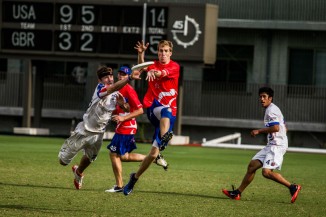With true Worlds in the books, it is time to start thinking about 2016’s campaign, a surprisingly short four years away. The time has come to put away the winner-goes system and implement a true National team.
Like 2004 and 2008, USA came away with gold and silver in the main two divisions. There was a swap this year as the men took care of business, while the women faltered. Even in victory, the Team USA men looked shaky in struggling with Australia and Canada. Comparing results from true Worlds and club Worlds shows an even more startling result. USA has won every gold medal (except in 2006, when the distance to Perth kept all but a partial Subzero away.) When the talent pool is level, no one can challenge the US. When other nations are combine their talent to make a super team, suddenly things are much more even. Team Japan won women’s this year by combining the top players from UNO, Huck and MUD. There is no question that a US National Team would out talent every other team in the world.
The challenge for any club team in a Worlds year is the double peak. You play a spring season built to peak at Worlds and then a fall season to peak for club Nationals in Sarasota. This double peak is extremely difficult to manage both physically and mentally. In 2008, Sockeye and Fury attempted an audacious triple: win the Dream Cup, win true Worlds, win Club Nationals. Fury pulled it off, but Sockeye missed on all three by a combined 5 points. When I watched both Revolver and Fury play in Sakai this July, I saw two teams that were incomplete. This was mostly evident on offense where both teams struggled with their conversion rate (goals/possessions). This number should be above 60% for men and 50% for women and in none of their big games did they approach these numbers. I attribute this entirely to the double peak. When I have watched the Club Series versions of these teams, their hallmark has been a nasty ability to possess the disc regardless of what the other team was doing defensively. All the other teams at Worlds existed only for Worlds and their focus was only on Worlds, giving their efforts and focus a sharpness that will always be lacking from a team attempting a double peak. A US National team would be built for Worlds and its focus would be right there.
The obvious rebuttal to this argument is that team chemistry outweighs talent every time. The immediate and snarky reply is “have you watched any NexGen in the past week?” Chemistry is an issue and deserves a more serious reply than that. Preparation has to be taken very seriously; the process and planning around a National team should be longer and more extensive than the current infrastructure around the U-19 and U-23 teams. The U-19 girls lost in 2010 to Colombia in part because they’d never been in a close game before that one; they had the talent to win, but not the experience together as a team. Fortunately, the summer before true World is open on the WFDF worlds rotation, opening the possibility for a two year preparatory campaign. Chemistry is a concern, but it is a beatable concern.
The final piece in my argument has not to do with competition, but fairness. In the history of Worlds, if you haven’t had the luck to play for a team from Seattle, San Francisco, NY or Boston you were never going to have the chance to represent your country at worlds. It doesn’t matter how good you were, you weren’t going to get to go. World Games has remedied this to an extent, but only 10 players actually make the trip: 6 men and 4 women – not exactly a full sampling of talent.
The standard for US Ultimate is gold and a National team will get us there consistently.
Late addendum:
USA Ultimate responded to a my request for comment on the US National team with the following statement:
“Refining our selection processes to sustain international excellence for all of our national teams is a significant component to our new strategic plan, which was revealed during the opening session at the U.S. Open convention earlier this month.
Although we won’t be rolling out the entire plan in detail until later this fall, now would be a great time to discuss our strategy, specifically as it relates to international competition while it’s on the front burner with WUGC and WJUC all current. “
Look for more details on Team USA in the next few weeks.
Feature photo of Team USA’s Kayla Jorgensen (Photo by Neil Gardner – nzsnaps.com)










Comments Policy: At Skyd, we value all legitimate contributions to the discussion of ultimate. However, please ensure your input is respectful. Hateful, slanderous, or disrespectful comments will be deleted. For grammatical, factual, and typographic errors, instead of leaving a comment, please e-mail our editors directly at editors [at] skydmagazine.com.